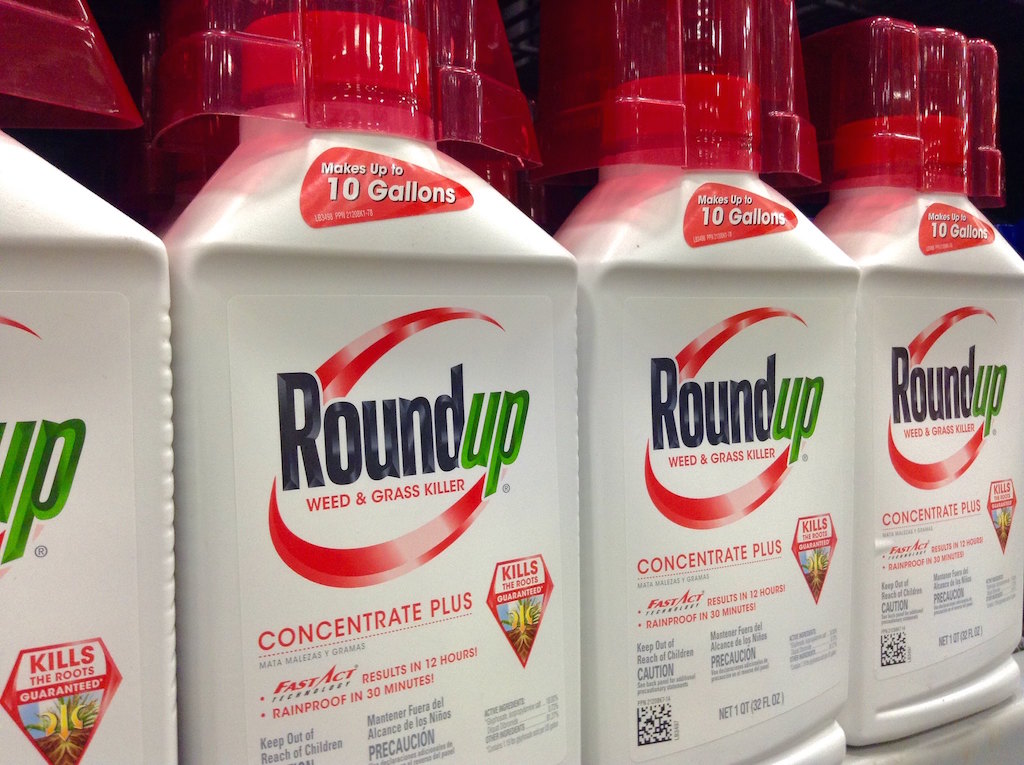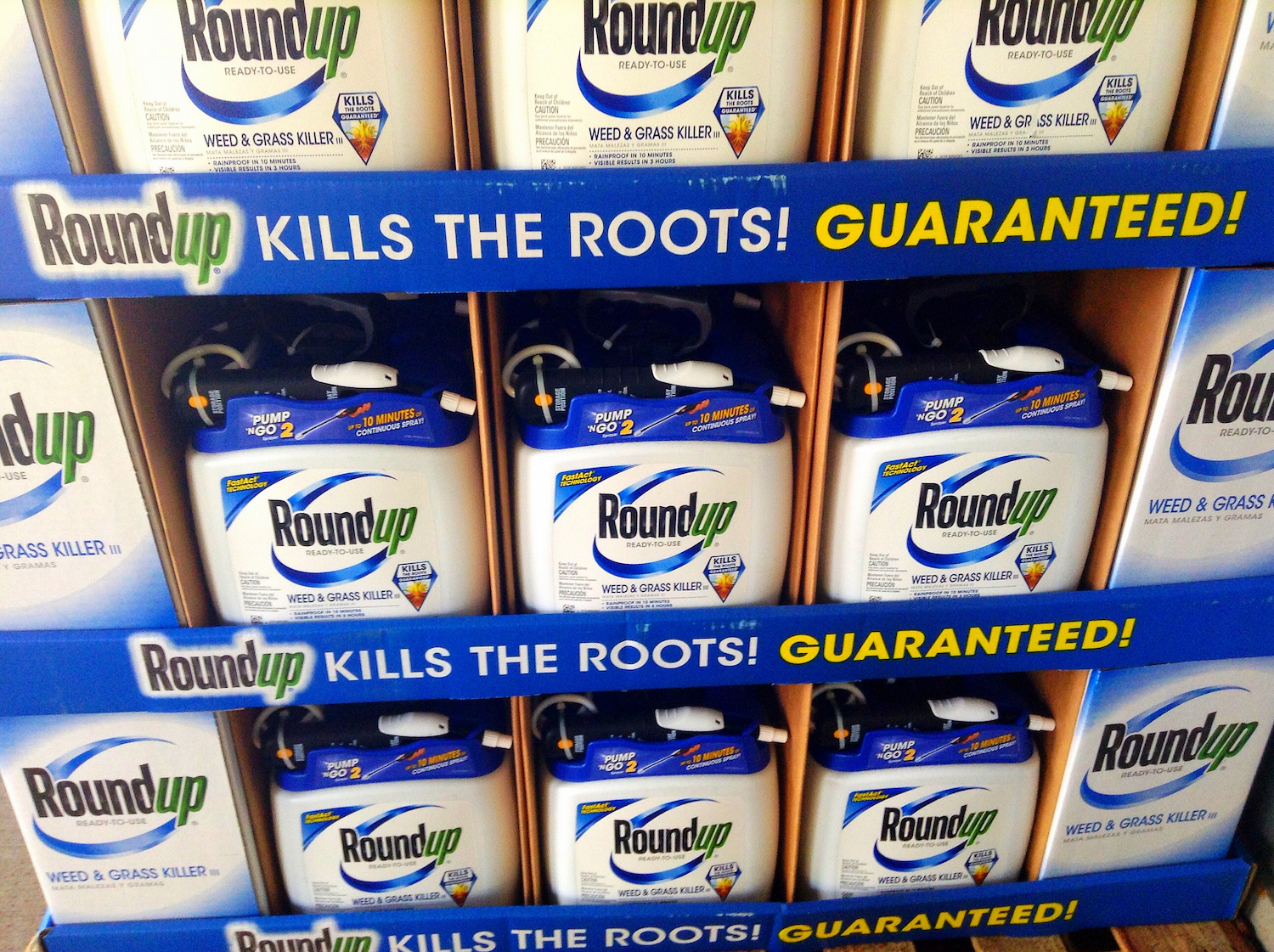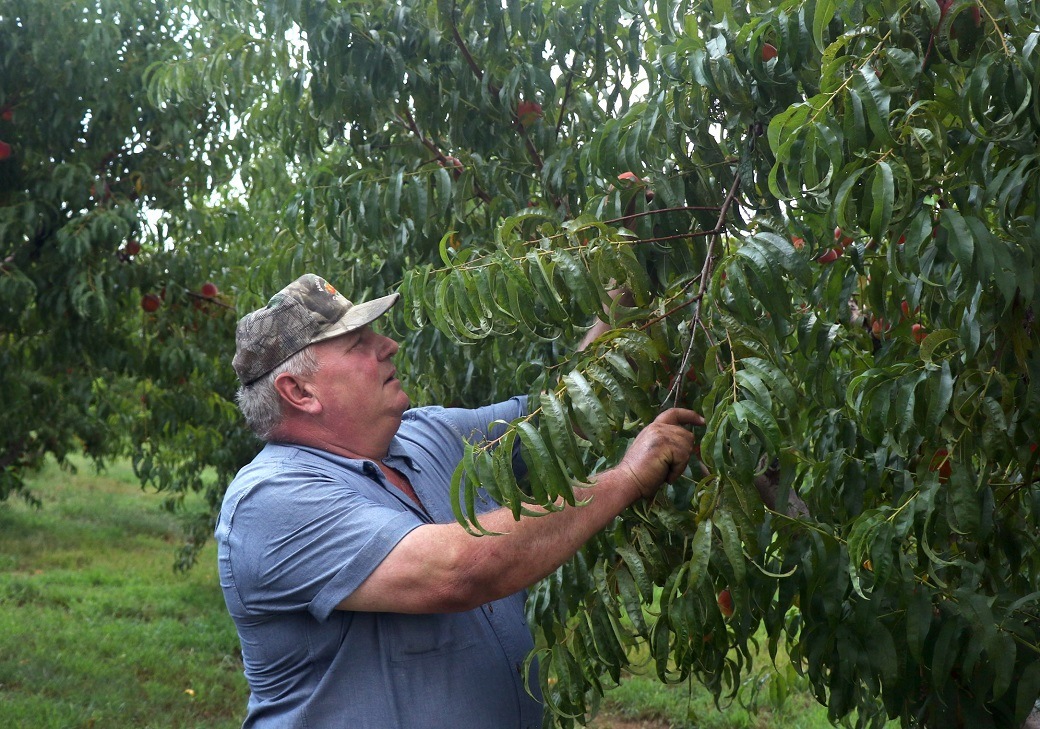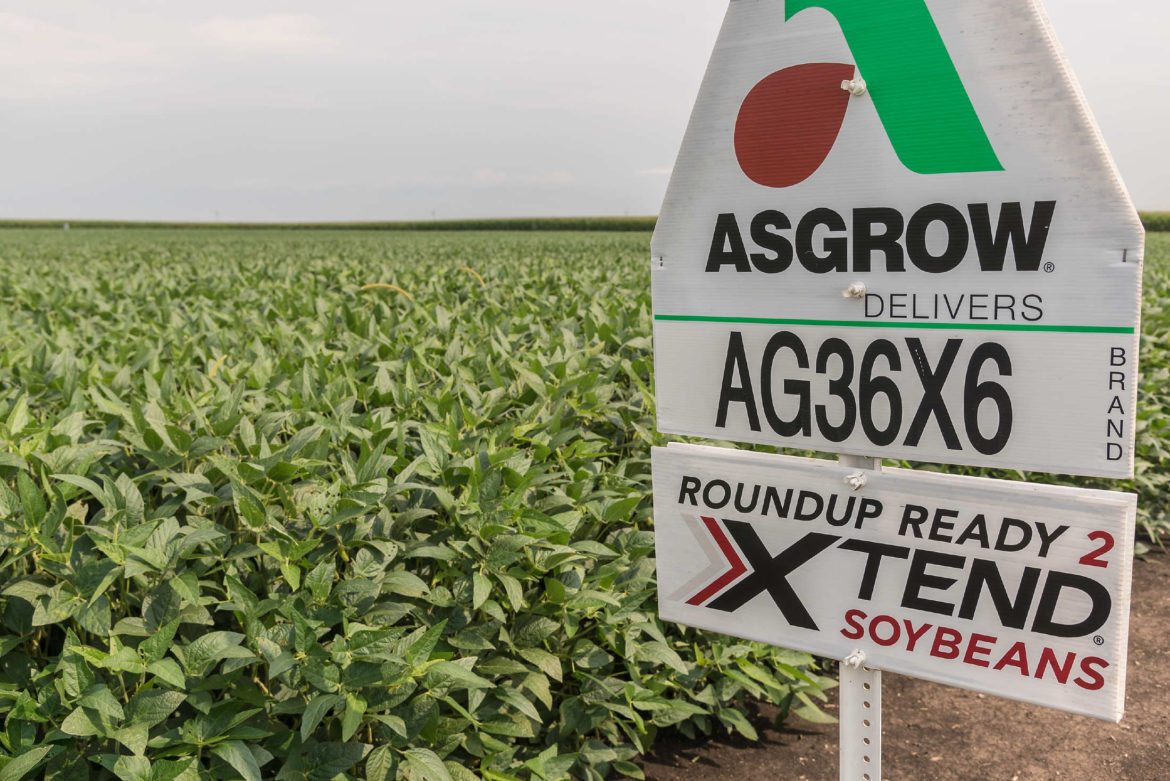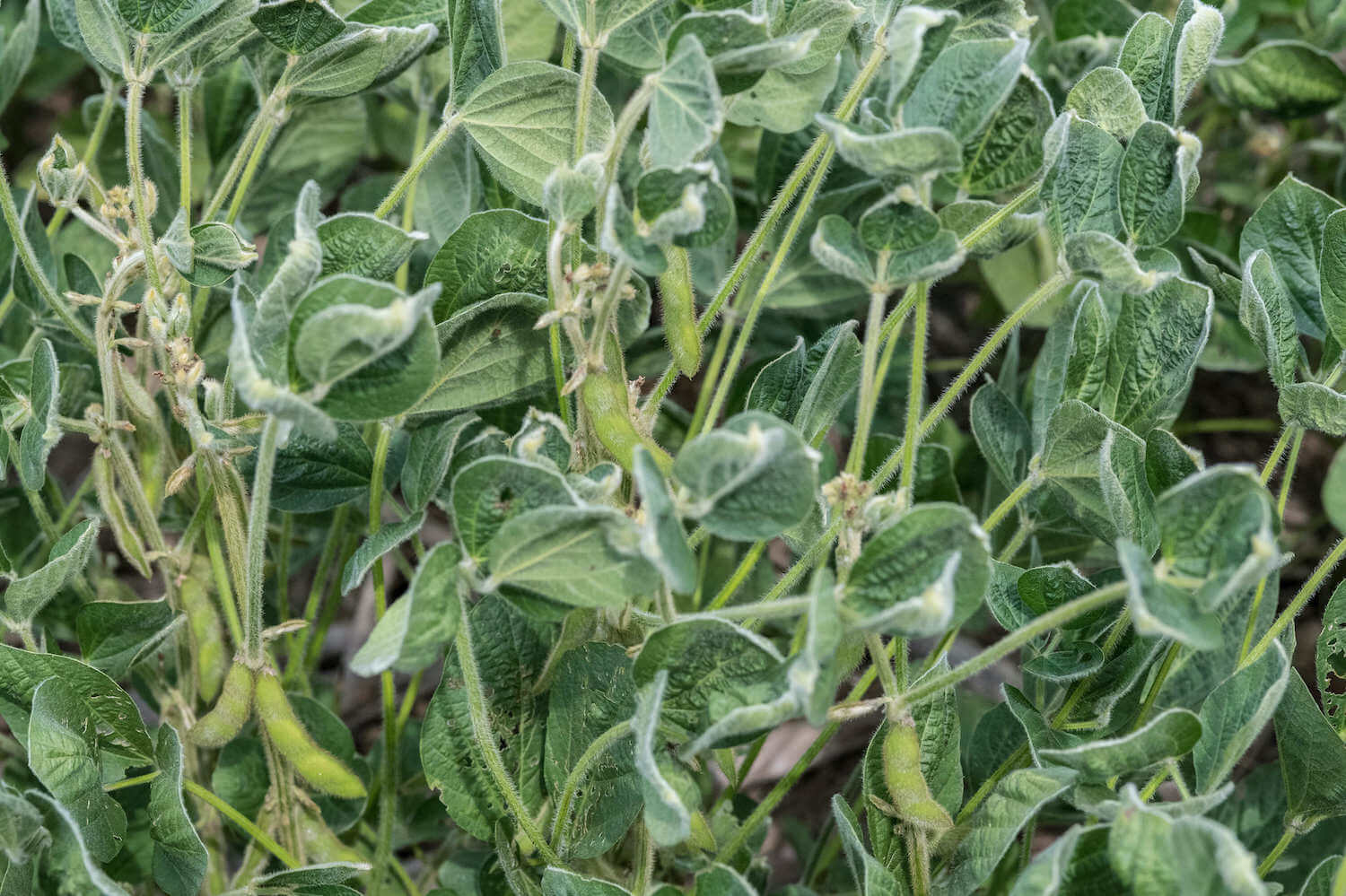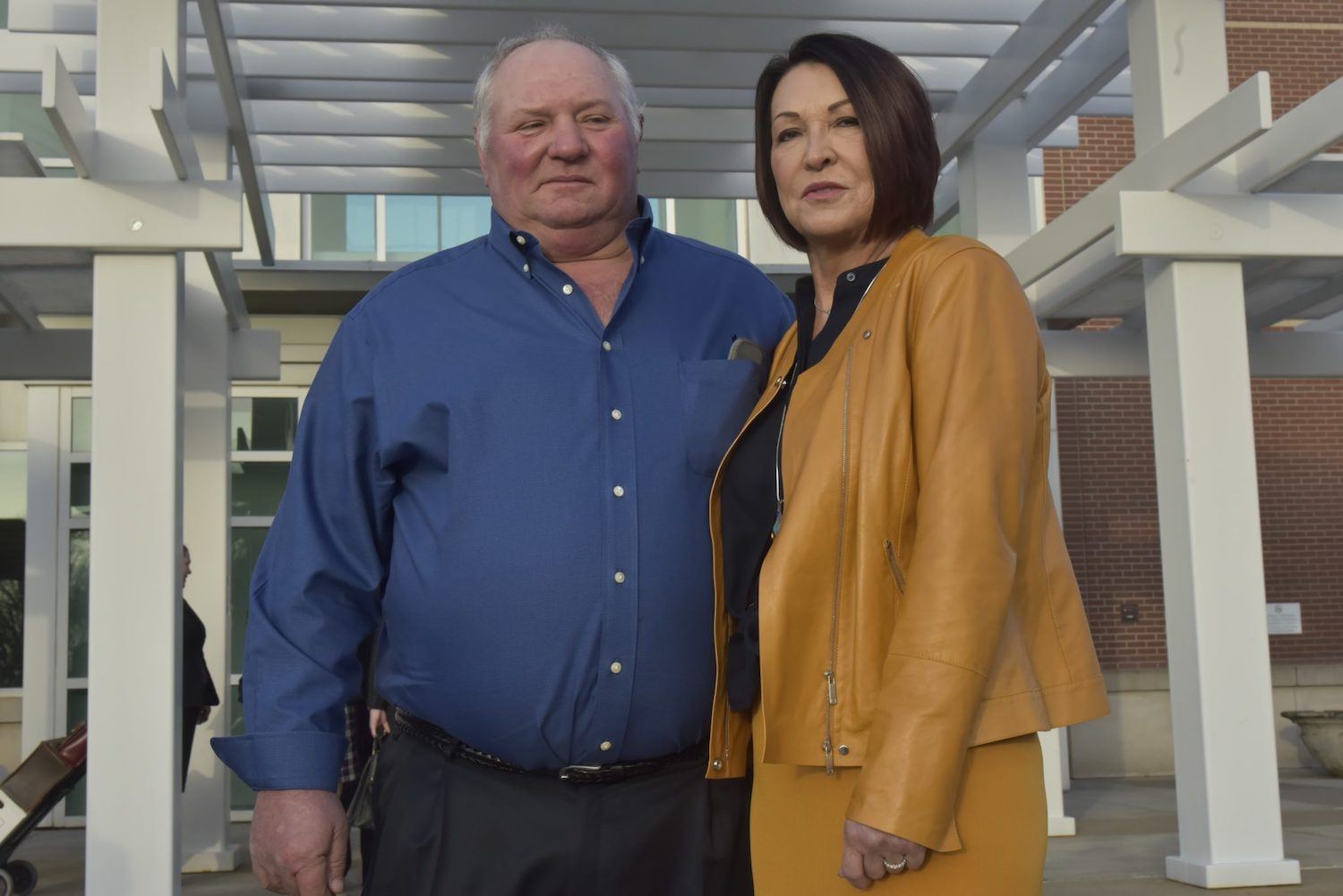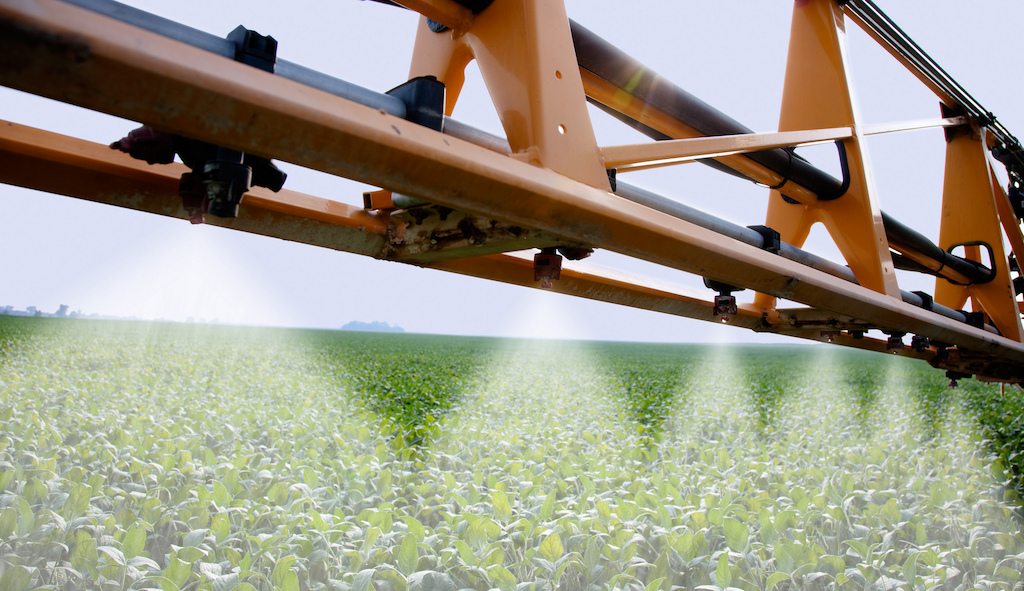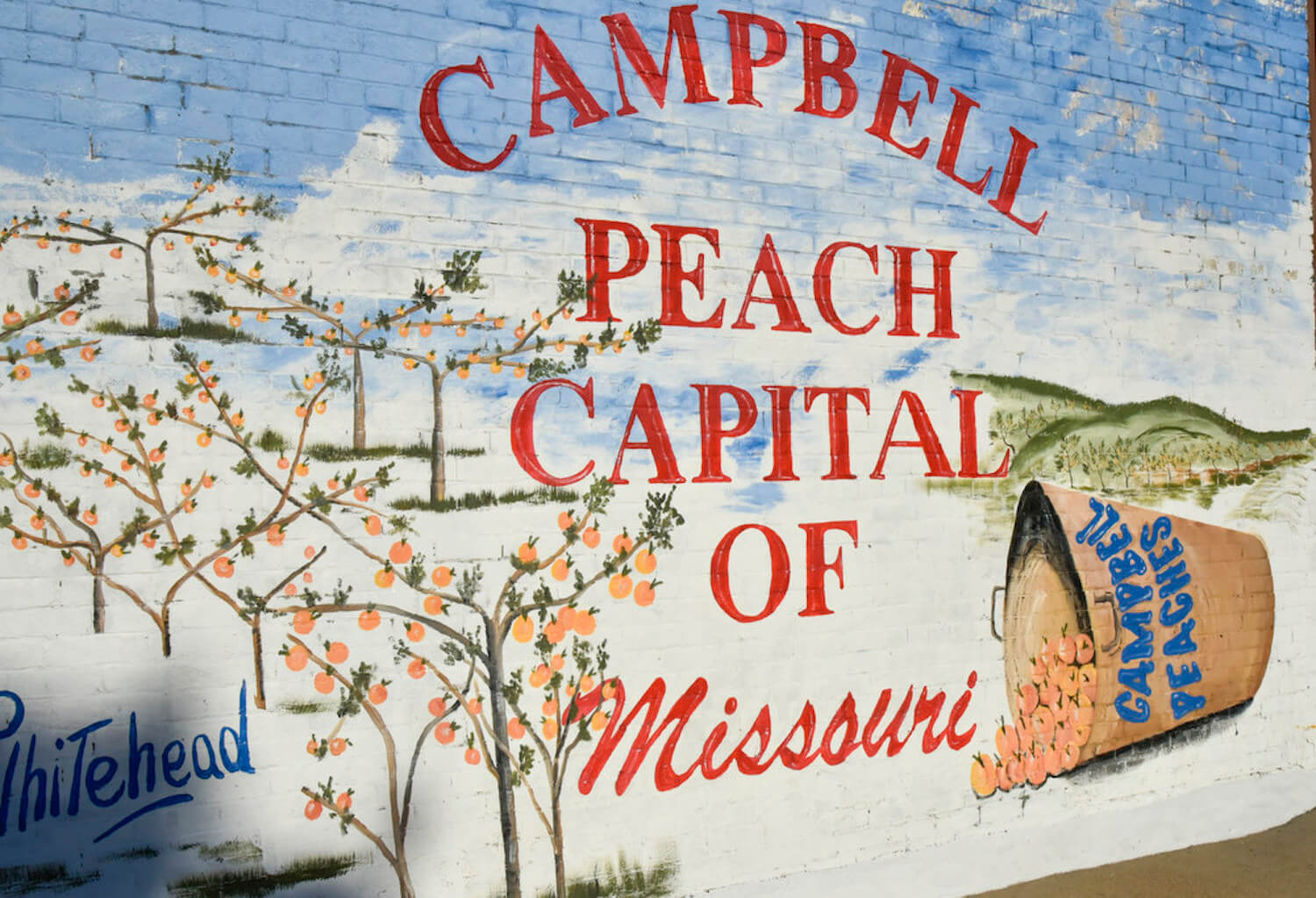
Darrell Hoemann, Midwest Center for Investigative Reporting
“Symptoms are showing up in backyards, school yards, cemeteries, forested lands, prairies, land enrolled in taxpayer funded conservation programs, orchards, vineyards, and even over large areas of small rural towns.”
Everything in Campbell, Missouri, is peaches. Peaches are on the water tower. You can order peach ice cream at the Sugar Shack on the edge of town. There is even a mural downtown depicting rows of peach trees and a full basket of fruit that declares the town the “Peach Capital of Missouri.”
The largest orchard in the area belongs to Bill Bader. His 1,000 acres of peaches have supplied grocery stores across eight states for more than three decades.
This article is republished from The Midwest Center for Investigative Reporting. Read the original article here.
But today, Bader can’t grow much of anything. His trees have been hit year after year by herbicides drifting from nearby farms. Bader’s farm has all but gone out of business. A couple years ago, in June, Bader went with his grandson to pick a peach, but couldn’t find a single one on the branch. The trees were so weak they couldn’t hold fruit.
It’s not only happening on Bader’s farm and it’s not only happening in the southeast Missouri town of Campbell, an investigation by the Midwest Center for Investigative Reporting found.
In recent years, farmers have been spraying an increasing amount of volatile herbicides – namely dicamba and 2,4-D – that are causing widespread damage to trees, native plants and natural areas across the Midwest and South.
“Symptoms are showing up in backyards, school yards, cemeteries, forested lands, prairies, land enrolled in taxpayer funded conservation programs, orchards, vineyards, and even over large areas of small rural towns.”
A federal court recently banned in-season application of dicamba, which experts say is responsible for the most damage, after finding the U.S. Environmental Protection Agency unlawfully approved the herbicide in a number of ways, including by failing to properly consider its effect on the environment. A court challenge filed by the same plaintiffs, alleging that the EPA also failed to do so for 2,4-D is currently pending.
Forest health experts said trees are being damaged from Indiana to Kansas, from North Dakota to Arkansas. Cupped up leaves, the most easily recognized symptom, can be seen in towns miles away from agricultural fields, as well as in nature preserves and state parks set aside as refuges for wildlife, experts said.
“Symptoms are showing up in backyards, school yards, cemeteries, forested lands, prairies, land enrolled in taxpayer funded conservation programs, orchards, vineyards, and even over large areas of small rural towns,” said Kim Erndt-Pitcher, habitat and agricultural programs specialist at Prairie Rivers Network, an Illinois-based environmental nonprofit that has conducted its own monitoring program over the past couple years.
In some areas, the damage is so severe that tree mortality is higher than from the Emerald Ash Borer, an insect that has killed tens of millions of trees across 25 states, experts said.
“These protected areas, these refuges, are so few and far between. They’ve dwindled so much over the years, and have increased so much in their importance. Any damage is magnified to that extent.”
“Our No. 1 problem on our trees is herbicide damage,” said Laurie Stepanek, forest health specialist with the Nebraska Forest Service. Stepanek said the damage has no boundaries, ranging from urban communities to native forests to tree nurseries. “We’ve got it everywhere, unfortunately. It’s so widespread and affecting so many trees.”
Trees that used to shade cemeteries in Arkansas have less foliage. In Central Illinois towns, iconic trees that were around at the time of Abe Lincoln are being harmed year after year. Nurseries in the St. Louis suburbs can’t sell their trees because the plants are too deformed.
More than 60 areas managed by the Illinois Department of Natural Resources, including state parks and nature preserves, reported herbicide damage in 2018 or 2019, according to records obtained by the Midwest Center for Investigative Reporting via the Freedom of Information Act. Some of the parks reported widespread death of mature oak trees.
Surveys of trees in Arkansas and Missouri also found damage to state and federal conservation areas.
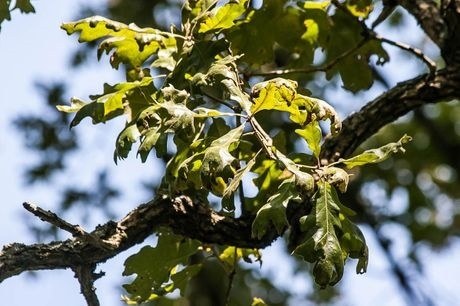
Illinois Department of Natural Resources
Oak trees exposed to herbicides like these documented by the Illinois Department of Natural Resources die slowly, with signs of damage visible in the foliage.
State parks and wildlife refuges matter because they provide rare, critical habitat, said Nathan Donley, a senior scientist at the Center for Biological Diversity.
“These protected areas, these refuges, are so few and far between. They’ve dwindled so much over the years, and have increased so much in their importance. Any damage is magnified to that extent,” Donley said. “Refuges are generally supposed to provide a refuge, and they do in a lot of cases, but you can’t separate the habitat from dicamba poison. Once it’s in the air, it’s going to drift wherever it decides to go, whether that’s a soy field or a refuge that provides essential habitat.”
More herbicides used to combat rise of superweeds
Tree damage from herbicides is nothing new. Trees serving as windbreaks in fields or shelter belts around rural homes often get a dose of herbicide damage on a windy day or when a sprayer gets too close, said John Ball, an extension forestry specialist with South Dakota State University.
But the scale of the damage in recent years is unprecedented.
For decades, glyphosate, the active ingredient in Roundup, has been the most commonly sprayed herbicide. The amount of glyphosate sprayed in crops increased 40-fold between 1992 and 2016. Over the past 25 years, the number of weeds resistant to glyphosate has increased from zero to more than 45, according to the International Survey of Herbicide Resistant Weeds.
In response, farmers have been increasingly spraying other herbicides to kill these pesky “superweeds” before the growing season. The two most prominent have been dicamba and 2,4-D.
Earlier this year, Bader was awarded $265 million by a federal jury in a lawsuit against Bayer and BASF where he claimed his peach orchard was no longer viable because of repeated damage from dicamba.
But farmers couldn’t make widespread applications of these herbicides during the growing season because they would kill crops like soybeans and cotton.
In order to combat this problem, agribusiness companies like Bayer, formerly Monsanto, and Corteva, formerly DowDuPont, have released new crops genetically engineered to withstand being sprayed by these herbicides.
Bayer’s Xtend system, which is resistant to dicamba, has become widely adopted since it was fully rolled out in 2017, being planted across 50 million acres of soybeans in 2020, or about two out of three soybeans planted in the US. Bayer and BASF, which are both headquartered in Germany, have the highest market shares of dicamba herbicide.
Since 2017, millions of acres of non-resistant crops have been damaged by dicamba, according to experts.
Bayer did not respond to a request for an interview for this story. However, in the past, the company has maintained that dicamba is safe when used according to its label and that off-target movement is unrelated to Bayer’s product.
Earlier this year, Bader was awarded $265 million by a federal jury in a lawsuit against Bayer and BASF where he claimed his peach orchard was no longer viable because of repeated damage from dicamba. Hundreds of other farmers have filed similar lawsuits, and many have the ability to become class action suits. The damage is also happening at nurseries and other speciality farms, experts said.
This year, Corteva’s Enlist system, which is resistant to 2,4-D, is expected to make up 20 percent of the soybean crop.
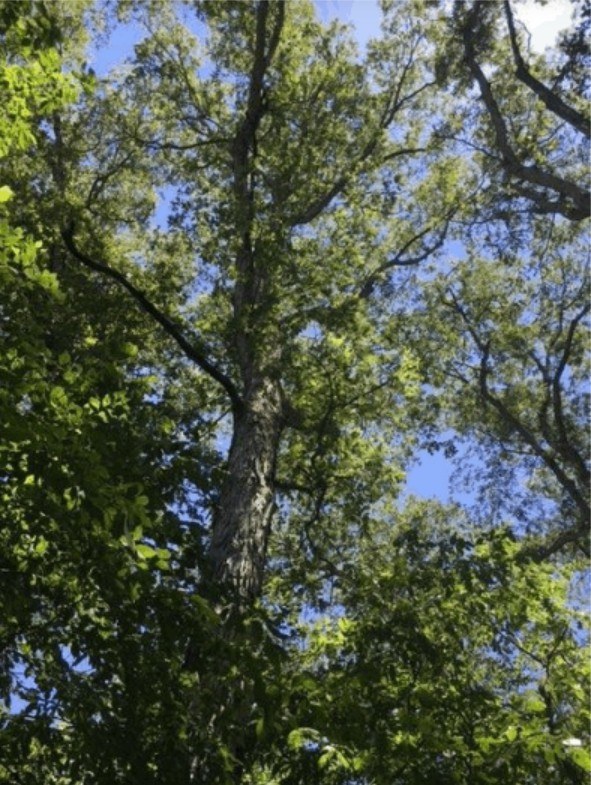
Tom Wilson, Illinois Department of Natural Resources
Tree damage from herbicides is nothing new. But the scale of the damage in recent years is unprecedented.
‘Don’t think you can get away from this’
But both herbicides are much more volatile than glyphosate. In the hours and days after the herbicides are sprayed, small amounts of the weed killer vaporize, turning into a gas and then move off the field.
Much of the damage is happening at the landscape level, which indicates volatility is likely at play through a phenomenon called atmospheric loading – when so many farmers are spraying so much herbicide at the same time that the chemicals build up to levels so high they are unable to dissipate and escape the atmosphere. The weed killer persists in the air for hours or even days, moving around by the wind and poisoning whatever it comes into contact with.
The pesticide can travel for miles, onto other crops, into towns and even into natural areas, said Marty Kemper, a retired biologist with the Illinois Department of Natural Resources. Kemper has been working with Prairie Rivers Network to document damage in southern Illinois, where he lives, and said trees just aren’t as healthy as they were five or six years ago.
“Don’t think you can get away from this by being inside the city limits,” Kemper said. “My observations are you can’t go anywhere in these small towns around here to not see some level of injury in these communities. For the last two years, I haven’t seen personally, a redbud in the town that I live in that didn’t show some level of exposure.”
In response to widespread inquiries about the damage, Ball organized a survey of forest health specialists to see if they could figure out how widespread the damage was. The group found significant damage from growth regulator herbicides in Illinois, Iowa, Indiana, Kansas, Missouri, Nebraska, North Dakota and South Dakota. Lab samples confirmed that 2,4-D was the most common pesticide detected, and dicamba was present in about 90 percent of samples. For example, in all of Nebraska’s 78 samples, leaves had detectable levels of dicamba and 2,4-D, Stepanek said.
“My observations are you can’t go anywhere in these small towns around here to not see some level of injury in these communities.”
The extent of the damage, as well as its long-term effects, is not known, Ball said. But widespread damage clearly happens throughout the growing season. Stepanek said she is most concerned about long-term chronic exposure year after year. Already, some trees are “just not growing very well.”
Lou Nelms, a retired biologist and former nursery owner who has documented tree injury in central Illinois for five straight years, has been finding injured sycamore trees in the middle of downtown areas across central Illinois, as far as a mile and a half from the closest crops. Lab samples confirmed dicamba was present.
Nelms can rattle off each of the places: near the public library in Clinton; outside of the Adams Wildlife Sanctuary in Springfield, right in front of the courthouse in Petersburg; at the large public park in Pekin; at Kickapoo Creek Park in Logan County; and at the Postville Courthouse in Lincoln.
“It’s a pretty good tell tale of just how far the dicamba gases have moved,” Nelms said.
Bill Freese, a science policy analyst at the Center for Food Safety, a nonprofit organization focused on human health and pesticides, said the effects could go beyond tree health to humans. Freese said his main concern about the spread of dicamba for humans is cancer.
Freese has submitted comments to the EPA and USDA about links between cancer and dicamba, though the agencies have not connected dicamba to cancer. A study released by the National Institutes of Health in May found that pesticide applicators who sprayed dicamba were more likely to develop certain types of cancer than pesticide applicators who did not spray dicamba.
2,4-D is considered a “possible human carcinogen” by the International Agency for Research on Cancer. Studies have also linked 2,4-D to endocrine disruption, disturbing estrogen, androgen and thyroid hormones.
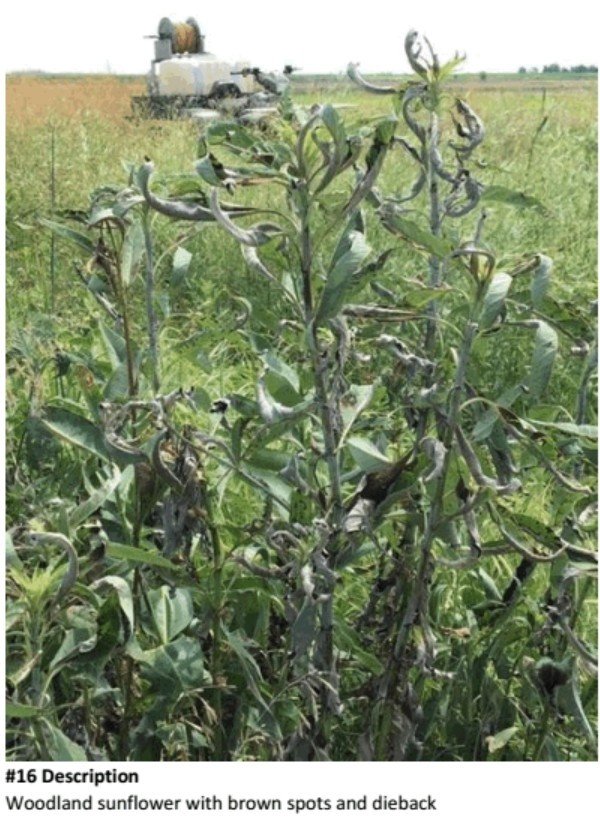
Tom Wilson, Illinois Department of Natural Resources
In 2019, species damaged by herbicide damage included woodland sunflowers.
‘Trees are just stuck there, getting sprayed year after year’
Detecting where the damage came from is often difficult, Ball said. That’s because a lot of times, the chemicals don’t come from just one field. They come from every field in the area, testified University of Arkansas professor emeritus of weed science Ford Baldwin in the Bader peach farm trial in federal court in February.
There’s a scenic drive in the middle of the 2,154-acre Big Cane Conservation Area in southern Missouri. While the area is surrounded by fields, the scenic drive is well insulated, said Robbie Doerhoff, a forest health specialist with the Missouri Department of Conservation. One day last summer, Doerhoff took the drive and conducted a random sampling of leaves that “weren’t terribly symptomatic.” Lab results found levels of 2,4-D and dicamba, she said.
“We don’t know what that means,” Doerhoff said. “As far as stress on the tree long-term, we have no idea what that means. The trees were all green, and the average person wouldn’t have noticed they looked weird.”
But other trees showed symptoms, and it could matter for the forest’s long-term health, she said.
“Big Cane is there because 99 percent of the habitat that used to be there – the swampy areas, the low-lying forest – is gone,” Doerhoff said. “We have little patches here and there set aside for wildlife species. Potentially, these herbicides are degrading these small areas we have.”
“As far as stress on the tree long-term, we have no idea what that means. The trees were all green, and the average person wouldn’t have noticed they looked weird.”
Doerhoff, who normally focuses on insects in trees, said she could see herbicides having a significant effect on species like caterpillars that are sensitive to which leaves they eat.
Fewer insects means less food for birds, said Dan Scheiman, bird conservation director of the Arkansas Audubon Society. Scheiman earned his Ph.D. from Purdue University and has been birding for more than 30 years.
Scheiman set up a volunteer monitoring program in 2019 that found 243 instances of damage across 17 counties inside natural wildlife refuges, natural areas and churchyards. Scheiman believes dicamba is largely to blame in Arkansas.
The worry is that trees and wildflower species will be less productive, and the seeds and fruits that birds need will disappear, Scheiman said.
He pointed out that soybeans are an annual plant, while trees are perennials.
“Trees are just stuck there, getting sprayed year after year,” Scheiman said.
Doerhoff said it all comes back to herbicides being used more than in the past.
“Dicamba and 2,4-D have been around for a long time, but they’ve been used differently.” Doerhoff said. “There has never been a push to study them in a new way, and they haven’t been used when mature trees are leafed out. Now it’s a problem and we don’t have any data.”
One of the best datasets might just be places like Bader’s peach farm, where yields have been documented year after year for decades. In the early 2000s, Bader averaged yields over 150,000 bushels. In 2018, his trees produced 12,000 bushels.
“There has never been a push to study them in a new way, and they haven’t been used when mature trees are leafed out. Now it’s a problem and we don’t have any data.”
In Campbell, just miles from Bader’s farm, there is a mural painted on the side of a downtown building. In the painting, cotton farmers coexist alongside peach trees. But today, that mural is more of a portrayal of a time gone past than the reality of the small town of about 2,000 people in Missouri’s southern panhandle, near the state’s border with Arkansas.
Peaches don’t grow in Campbell anymore. At least, not the way they used to.
More than 60 areas managed by the Illinois Department of Natural Resource, including state parks and nature preserves, reported herbicide damage in 2018 or 2019, according to records obtained by the Midwest Center for Investigative Reporting via the Illinois Freedom of Information Act. Below are excerpts of damage reports at DNR lands across Illinois.
The 25-acre Marissa Woods Nature Preserve in St. Clair County is a good example of an undisturbed forest and likely was once a savannah that is now changing due to lack of fire. In 2019, biologists reported two dozen dead oaks, along with more than 100 oak and hickory trees showing significant herbicide damage.
The 35-acre Julius J. Knobeloch Woods in St. Clair County is designed to provide “educational opportunities to those who might otherwise never experience a natural area” and includes a .7 mile scenic drive. In 2019, Biologists observed damage in 12 species from 10 plant families. “Thin canopies, dieback, and mortality appear to have trended upward since 2017.” About 30 trees, mostly oaks, had recently died.
The 2,900-acre Big River State Forest in Henderson County is “a remnant of a vast prairie woodland border area that once covered much of Illinois and home to two endangered plants.” In 2019, state biologists reported that some trees had died “likely from previous years’ damage. All new growth (this year’s growth) was affected by brown patches or cupping at margins.”
The 196-acre Sipple Slough Woods in Washington County is home to a locally rare population of a wildflower called Aureolaria grandiflora. But in 2019, biologists reported that it was “significantly depressed” and that more than 100 oak trees had herbicide damage. The site had been damaged the year before. “Overall foliage injury level appears less than in 2018 but the overall health of the oak trees at this site has not improved and appears to have declined slightly. A number of trees demonstrate epicormic branching and dieback with some mortality.”
Mature oaks “have been dying for several years” at the 40-acre Goode’s Woods in Macoupin County, and nearly all mature oaks have reduced leaf size and thin canopy coverage, state biologists reported in 2019.
The 12-acre Sunbury Railroad Prairie in Livingston County preserves rare but important habitat for several mammals and grassland birds. But in 2019, species damaged by herbicide damage included ”obedient plant, woodland sunflowers (approx. 100 individuals), drooping coneflower, rigid goldenrod, milkweed, leadplant, bee-balm monarda, round-headed bush clover, flowering spurge, ironweed, asters, prairie dropseed, cherry, and prairie dock.”

